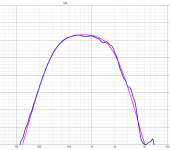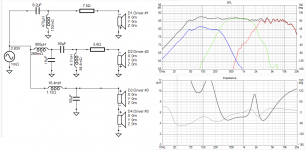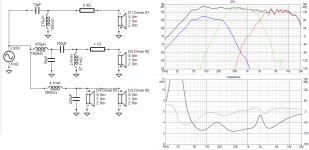It’s not so much about amplitude but about phase. By stacking the lowpass of the mid and the highpass of the tweeter behind the highpass of the mid, phase relations between mid and high are maintained better. Although this is only valid when acoustic centers have been aligned. And the same of course applies for bass and mid, but no one brings that up.
If the slopes are the same, then phase should come together. If it doesn't then we can discuss the accuracy of them too... However I noticed a problem with these slopes coming together only slightly further down and it's hard to see. You can be more certain of this if working to a target, if you set it up. In Xsim this can be done by creating another default driver and giving it standard curves to compare to.
Example..
Example..
Attachments
Allen, I was trying to do it in Xsim and also in VituixCAD but I was not able. I am angry at my self but absolutely don´t know how to do that. I am sorry.
I put your crossover from thread no. 33 to Xsim and it looks fantastic. Very simple but brilliant. There is also a bass boost up to +6 dB (not visible at screenshot from VituixCAD) which is great and which I love. I tried to put another woofer in series but it was a mess.
Please, could you help me with it? Your crossover is really awesome and I see that one woofer would be enough but in my project there sould be two woofers to have a better look so please, is it possible to make it somehow with two? Is then possible to increase the SPL of midrange and tweeter to keep the bass boost not more than +6 dB? Could you do it for me, please?
I put your crossover from thread no. 33 to Xsim and it looks fantastic. Very simple but brilliant. There is also a bass boost up to +6 dB (not visible at screenshot from VituixCAD) which is great and which I love. I tried to put another woofer in series but it was a mess.
Please, could you help me with it? Your crossover is really awesome and I see that one woofer would be enough but in my project there sould be two woofers to have a better look so please, is it possible to make it somehow with two? Is then possible to increase the SPL of midrange and tweeter to keep the bass boost not more than +6 dB? Could you do it for me, please?
Last edited:
Vacuphile, I don't want you to think I was dismissing your idea this morning. Of course your theory is correct. What I've done here hasn't given it its proper due. We may have discussed it in the past.Your first stage needs to separate between bass and mid/tweet.
Please review my design?
It's a minor adjustment.
Allen, thank you so much. It´s great and now it meets all my requirements.
Thank you once again for your help. And I want to thank all guys who tried to help me, I appreciate it very much.
Vacuphile, I don't want you to think I was dismissing your idea this morning. Of course your theory is correct. What I've done here hasn't given it its proper due. We may have discussed it in the past.
Please review my design?
Now I understand how to work with a target slope.
Thank you.
It’s not so much about amplitude but about phase. By stacking the lowpass of the mid and the highpass of the tweeter behind the highpass of the mid, phase relations between mid and high are maintained better. Although this is only valid when acoustic centers have been aligned. And the same of course applies for bass and mid, but no one brings that up.
Now I understand what you have ment after reading Allen´s link to vacuphile.
Thank you.
I have one more question.
It seems that two woofers in paralel increase SPL by 6 dB while is series lower the SPL by 6 dB. Is that correct? If so it seems using two woofers in series is waste of money. That was the reason why I wanted to use them in paralel to have higher SPL but now I see other problems caused by paralel connection.
It seems that two woofers in paralel increase SPL by 6 dB while is series lower the SPL by 6 dB. Is that correct? If so it seems using two woofers in series is waste of money. That was the reason why I wanted to use them in paralel to have higher SPL but now I see other problems caused by paralel connection.
two woofer in parallel increase sensitivity (dB per volt) by 6 dB, and increase efficiency (dB per Watt) by 3 dB. Impedance is half that of a single woofer.
Two woofers in series increase sensitivity (dB per volt) by 0 dB, and increase efficiency (dB per Watt) by 3 dB. Impedance is twice that of a single woofer.
In either case, the max power handling of the system is doubled, and the max SPL capability of the system goes up by +6 dB.
Two woofers in series increase sensitivity (dB per volt) by 0 dB, and increase efficiency (dB per Watt) by 3 dB. Impedance is twice that of a single woofer.
In either case, the max power handling of the system is doubled, and the max SPL capability of the system goes up by +6 dB.
The low impedance being difficult for the average amp (see the example, I didn't try too hard because I remembered it was tricky with this mid, but you might find a way). Also markbakk feels the mid will run to its limit before even one woofer does so you won't get the most out of them.other problems caused by paralel connection.
So, if you can supply some more voltage from the amp the result should be near the same.
Attachments
two woofer in parallel increase sensitivity (dB per volt) by 6 dB, and increase efficiency (dB per Watt) by 3 dB. Impedance is half that of a single woofer.
Two woofers in series increase sensitivity (dB per volt) by 0 dB, and increase efficiency (dB per Watt) by 3 dB. Impedance is twice that of a single woofer.
In either case, the max power handling of the system is doubled, and the max SPL capability of the system goes up by +6 dB.
Thank you very much, now I understand.
The low impedance being difficult for the average amp (see the example, I didn't try too hard because I remembered it was tricky with this mid, but you might find a way). Also markbakk feels the mid will run to its limit before even one woofer does so you won't get the most out of them.
So, if you can supply some more voltage from the amp the result should be near the same.
Thank you. I did not understand markbakk well because english is not my native languge so I am sorry but now I understand much better.
So guys you think I should use some other mid?
Allen, I made one more crossover. Please, if you have time could you check if it is totaly wrong or just wrong.
Attachments
2 woofers in parallel gain 3dB by doubling surface area and another 3dB by halving impedance = +6fB
2 woofers in series gain 3dB by doubling surface area but lose 3dB by doubling impedance = +/-0dB
So why do series woofers if the output is the same?
a) you still double power handling
b) you want a better impedance to your amplifier in the bass region where most current is demanded.
2 woofers in series gain 3dB by doubling surface area but lose 3dB by doubling impedance = +/-0dB
So why do series woofers if the output is the same?
a) you still double power handling
b) you want a better impedance to your amplifier in the bass region where most current is demanded.
Hmmm, are you really after a structural bass boost by 6dB? As most of us here would not and Allen has designed a crossover essentially measuring flat (that is how it's meant from the recording). Apart from that, the room gain will add bass enough, depending on the setup up til about 9dB, apart from room modes.
The adding of drivers works thus: at relatively low frequencies (wavelength bigger than 3 times the diameter of the drivers) double woofers close to each other will produce double the sound pressure level at listening distance. By switching them in series, you'll bring the sound pressure of each woofer back to half the original level. So essentially, the series switching leads to +/- 0dB SPL, but at double the impedance (and half the current from the amp).
If you switch them in parallel however, you end up with +6dB SPL. You will need efficiency figures for your mid and tweeter that are in that new ballpark to successfully establish a speaker that is well-balanced. But hey, if you really want that bass-heavy (ear-tiring) set, no one here will stop you
The adding of drivers works thus: at relatively low frequencies (wavelength bigger than 3 times the diameter of the drivers) double woofers close to each other will produce double the sound pressure level at listening distance. By switching them in series, you'll bring the sound pressure of each woofer back to half the original level. So essentially, the series switching leads to +/- 0dB SPL, but at double the impedance (and half the current from the amp).
If you switch them in parallel however, you end up with +6dB SPL. You will need efficiency figures for your mid and tweeter that are in that new ballpark to successfully establish a speaker that is well-balanced. But hey, if you really want that bass-heavy (ear-tiring) set, no one here will stop you
Last edited:
It's mine neither, so we both started from the last grid rowsI did not understand markbakk well because english is not my native languge so I am sorry
2 woofers in parallel gain 3dB by doubling surface area and another 3dB by halving impedance = +6fB
2 woofers in series gain 3dB by doubling surface area but lose 3dB by doubling impedance = +/-0dB
So why do series woofers if the output is the same?
a) you still double power handling
b) you want a better impedance to your amplifier in the bass region where most current is demanded.
Thank you for very much for clear explanation. Now I understand it much better.
- Home
- Loudspeakers
- Multi-Way
- Please review my 3-way crossover


